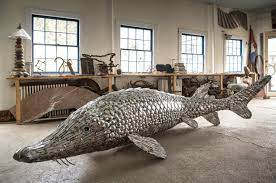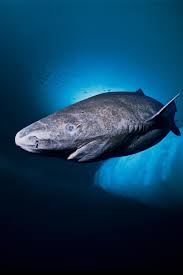The sturgeon fish, with its ancient lineage and enigmatic presence in freshwater habitats, has long intrigued biologists and fisheries enthusiasts alike. These prehistoric creatures, known for their impressive size, longevity, and caviar-producing abilities, hold a special place in both natural history and human culture. In this article, we embark on a journey to explore 60 captivating facts about
sturgeon fish, shedding light on their biology, behavior, and significance in the world of aquatic life.

- Ancient Fish Lineage: Sturgeon fish belong to an ancient lineage that has existed for over 200 million years.
- Impressive Size: Some sturgeon species can grow to be enormous, with lengths exceeding 18 feet (5.5 meters).
- Longevity Records: Sturgeon fish are known for their remarkable lifespans, often living for several decades or even over a century.
- Ancient Fossils: Fossils of sturgeon ancestors date back to the Jurassic period, showcasing their enduring presence on Earth.
- Ecosystem Engineers: Sturgeons play a crucial role in shaping aquatic ecosystems through their feeding habits.
- Caviar Producers: Sturgeon roe, known as caviar, is one of the most sought-after and valuable luxury foods in the world.
- Multiple Sturgeon Species: There are around 27 recognized sturgeon species, each with its own unique characteristics.
- Native to Northern Hemisphere: Sturgeon fish are primarily found in the Northern Hemisphere, inhabiting rivers, lakes, and coastal waters.
- Ancient Records: Historical documents from ancient civilizations mention sturgeon and their prized roe.
- Exceptional Swimmers: Sturgeons are powerful swimmers, capable of navigating against strong currents.
- Bottom Feeders: They are benthic feeders, scouring riverbeds and lake bottoms for their meals.
- Feeding Adaptations: Sturgeons have specialized barbels near their mouths to help detect prey hidden in sediment.
- High Demand for Caviar: The demand for sturgeon caviar has led to overfishing and illegal poaching in some regions.
- Conservation Efforts: Many countries have implemented conservation measures to protect sturgeon populations.
- Unique Life Cycle: Sturgeon have a complex life cycle, involving both freshwater and saltwater habitats.
- Habitat Migration: Some sturgeon species migrate between freshwater and marine environments during their life stages.
- Dramatic Spawning Rituals: Sturgeon spawning involves leaping out of the water, which can be a breathtaking sight.
- Roe Harvesting: The caviar industry involves the harvesting of sturgeon eggs, which are processed and sold as a luxury product.
- Cultural Significance: Sturgeon and their caviar hold cultural significance in various regions, particularly in Europe and Asia.
- Sturgeon Farming: Aquaculture practices have been developed to sustainably farm sturgeon and produce caviar.
- Sturgeon Conservation: Conservation organizations work to protect sturgeon species and their habitats.
- Invasive Species Threats: Invasive species pose a threat to sturgeon populations by competing for resources.
- Illegal Trade: The illegal trade in sturgeon caviar has led to efforts to combat wildlife trafficking.
- Unique Sensory Organs: Sturgeon fish possess electroreceptors on their snouts, helping them detect prey.
- Ancient Harvesting Methods: Historically, sturgeon were captured using nets, spears, and traps.
- Prehistoric Appearance: Sturgeons have a distinctive prehistoric appearance, with elongated bodies and bony plates called scutes.
- Bony Armor: The scutes on sturgeon bodies serve as protective armor against predators.
- Global Distribution: Sturgeon species can be found in various countries, including the United States, Russia, and China.
- Legal Protection: Many sturgeon species are protected by international agreements such as CITES.
- Caviar Alternatives: Sustainable alternatives to traditional sturgeon caviar are being explored using other fish species.

- Hybridization Concerns: The interbreeding of sturgeon species can pose challenges for conservation efforts.
- Gourmet Cuisine: Beyond caviar, sturgeon meat is considered a delicacy in some cuisines.
- Sturgeon Roe Types: There are different types of caviar depending on the sturgeon species, including Beluga, Osetra, and Sevruga.
- Habitat Destruction: Habitat loss due to dam construction and pollution threatens sturgeon populations.
- Global Fishing Regulations: International regulations govern the fishing and trade of sturgeon and their products.
- Restocking Programs: Some regions have implemented sturgeon restocking programs to bolster populations.
- Hybrid Caviar Production: Hybrid sturgeon species are sometimes bred for caviar production.
- Artificial Insemination: Techniques like artificial insemination are used in sturgeon aquaculture.
- Challenges in Sturgeon Farming: Rearing sturgeon in captivity can be challenging due to their complex needs.
- Sturgeon bycatch: Commercial fishing operations unintentionally catch sturgeon as bycatch.
- Mercury Concerns: Sturgeon can accumulate mercury in their tissues, posing health risks for humans who consume them.
- Sturgeon Research: Ongoing scientific research aims to better understand sturgeon biology and ecology.
- Sturgeon Roe Substitutes: Efforts are underway to develop plant-based and synthetic alternatives to caviar.
- Sturgeon Tourism: Some regions have developed sturgeon-related tourism to raise awareness and support conservation.
- Sturgeon-Saving Innovations: Creative solutions, such as caviar produced from non-sturgeon species, are emerging.
- Sturgeon Anatomy: Sturgeon have unique cartilaginous skeletons, distinguishing them from bony fish.
- Sturgeon Endangerment: Several sturgeon species are classified as endangered or critically endangered.
- Sturgeon DNA Studies: DNA analysis has shed light on the genetic diversity of sturgeon populations.
- International Cooperation: Sturgeon conservation requires collaboration between countries and organizations.
- Sturgeon Diving: Some adventurous divers seek out sturgeon encounters in their natural habitats.
- Sturgeon Trade Bans: Some countries have imposed bans on sturgeon caviar imports to protect wild populations.
- Ethical Caviar: Ethical caviar initiatives promote sustainable and humane caviar production.
- Sturgeon Artifacts: Ancient artifacts, including sturgeon-shaped amulets, highlight their historical significance.
- Sturgeon-Pollution Link: Sturgeon populations are vulnerable to pollution-related diseases.
- Sturgeon Genetic Diversity: Genetic diversity is essential for the long-term survival of sturgeon species.
- Sturgeon Aquaculture Innovation: Sustainable aquaculture practices are crucial for sturgeon conservation.
- Sturgeon Anatomy and Physiology: Sturgeon’s unique features have adapted them to various aquatic environments.

- Sturgeon in Folklore: Sturgeon are featured in the folklore and mythology of many cultures.
- Sturgeon Taste: Sturgeon meat is described as delicate, mild, and similar to other white fish.
- Sturgeon Legacy: The sturgeon’s ancient lineage and cultural significance ensure its enduring legacy in the world of aquatic life.



















Add Comment